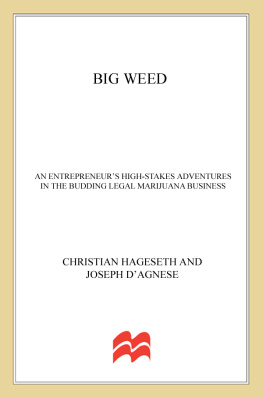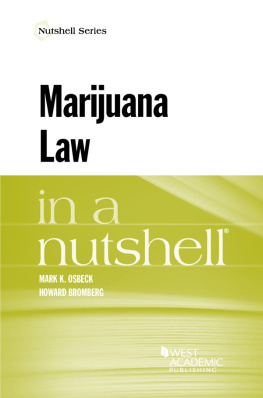Big

Weed
An Entrepreneurs High-Stakes Adventures in the Budding Legal Marijuana Business
Christian Hageseth
with
Joseph DAgnese

The author and publisher have provided this e-book to you for your personal use only. You may not make this e-book publicly available in any way. Copyright infringement is against the law. If you believe the copy of this e-book you are reading infringes on the authors copyright, please notify the publisher at: us.macmillanusa.com/piracy.
Contents
Introduction
When I left my house on a beautiful morning in February 2013, I was carrying $40,000 in cash in my backpack. The sun was just hitting the foothills of the Rockies as I drove out of Lowry, the neighborhood where I live in Denver. As you might surmise from the contents of the backpack, it was going to be a big day.
My first appointment was the most important. I was meeting with an architect Id hired several months ago to design a building I was planning to construct somewhere within Denver city limits. The first building of its kind anywhere in the world.
The architect ushered me into his office and we chatted while we looked over the plans together. The model was awesome. Id never seen anything so beautiful, except perhaps the faces of my children. And this building, in a way, was a child of mine. Any entrepreneur would recognize the feeling I was having. When you have an idea for a business, bringing it into the world takes hard work, money, and imagination. You have to nurture it, just as you would a child.
I was a long way from actually building the place. But all I needed at the moment were detailed drawings and a scale model to sell the dream. People are funny; they have trouble accessing their imaginations. If you dont show them a picture of what youre envisioning, they just wont get it. These images and models were meant to help others see what I saw. With this project, I was going to have to sell the dream to a lot of people: current shareholders, future investors, regulators, my employees, and the media. I would turn to this model again and again to show my vision to many people along the way.
And here in front of me, my vision had come to life: a visitors center with 50-foot-high cathedral ceilings; a restaurant and bar overlooking the outdoor amphitheater and greenhouse; a gift shop; an engaging behind-the-scenes tour open to the public; and cottages for visiting musicians, artists, and craftspeople. The whole facility would be powered by the cleanest, greenest energy we could find. I intended to shoot for LEED Platinum status, the highest green building certification in the construction business.
I had poured all my hope and energy into this place. Someday, when my customers walked in and were surrounded by glass and stone and light, when they were confronted with a 40-foot-high wall of living plants and heard the trickling of the indoor waterfall that flowed over the face of the Green Manthe emblem of my companyI wanted them to be struck by one awesome fact:
This place is special. Its a cathedral to the Mother Nature aspect of God. We are all connected to Nature. We share it together and cannot be separated from it.
By the way, I told the architect, I brought your money.
I started placing 1-inch stacks of hundred-dollar bills on his desk. Whoa! he said. What are you doing?
What does it look like? Im paying you.
Dude, we talked about this. It has to be by check. Otherwise were going to have a problem. He leaned forward, his face suddenly anxious and awkward. That face? I know that face very well. Ive seen it countless times since getting into this industry five years ago. Chris, you know I cant take this. Its drug money.
Oh. Yeah. I forget sometimes.
I should back up and explain something. My name is Christian Hageseth and I sell marijuana for a living. Honest-to-goodness, legal marijuana. That building my architect just designed for me? Its destined to be the worlds first weedery. Not a winery. Not a brewery. A weedery. A $30 million tourist destination. A chance to get inside the action with Americas newest and fastest-growing industry.
When I started my business, Green Man Cannabis, in 2009, I sold medical marijuana. My customers were people who suffered from nausea following rounds of chemotherapy. Or they had crippling migraines. Some had old surfing injuries that still flared up and threatened to ruin their days. All these people and more stopped by one of our dispensaries and allowed us to sell them some bud. With our product in hand, they were able to light up, toke away, and start feeling better in minutes.
We grossed about $300,000 that first year. In 2014, when recreational marijuana became legal in the state of Colorado and any resident over the age of twenty-one could walk in and buy up to an ounce of weed without fear of being busted by the cops, sales throughout the state jumped. We grossed $4 million that year, and our firm wasnt even catering to the recreational market. Not yet, anyway. I was holding back, biding my time until we were ready and I could roll out something so unforgettable that every marijuana smoker or enthusiast in the world would want to see for themselves.
When the weedery, which we will hereafter call the Green Man Cannabis Ranch, comes online, we anticipate doing about $97 million in revenue in our first year. Thats the radical leap in revenue that all businesses hope for but few ever realize. We will be able to do it because we were in the right place at the right time, operating a business that was doing things the right way. Everything in our companys past had led inevitably to this big moment.
We werent alone. Since marijuana first became legal in 2000, the state of Colorado has issued nearly a thousand marijuana licenses. People are fond of saying that there are more places to buy legal marijuana in Colorado than there are Starbucks. But despite its seeming ubiquity, the cannabis industry has a long way to go. It is still a little rough around the edges. Still has a lot of kinks to iron out. One of those kinks is what to do with all the cash the industry generates. Cash that makes people like my architect nervous.
What hed just said Its drug money! hung in the air between us.
Look, I said. You dont have a problem. Youre being paid for your architectural services. Im the one whos being paid for marijuana. You dont have a problem I do.
When we first started working together, we agreed. You agreed to pay by check.
Yeah, I did. And I had wanted to honor that request. I really did, just as I have for every vendor of ours who made the same request. But the law of the land at the time didnt allow us to enjoy the benefits of banking. In my business, marijuana and banks dont mix.
In 2009, the state of Colorado racked up such a huge marijuana slush fund that it was able to reach in and help itself to $3 million to balance the state budget. In 2010, it used $9 million from the same fund to do it again. The state was facing a $60 million shortfall because it was not receiving as much federal Medicaid assistance as it had in the past. (This had nothing to do with the world of medical marijuana, by the way; it was just federal budget cutting as usual.) Governor Bill Ritter admitted that he had opposed making medical marijuana legal, but when the chips are down, cash is cash. Thanks to more than 150,000 state residents who had paid fees into the medical marijuana program cash fund to be allowed access to medical weed, and we ganjapreneurs, as we were sometimes called, who supplied the product, the states butt was saved. Capitalism had ridden in on a big, green, sticky horse and saved the day. Yay, weed.
Next page













